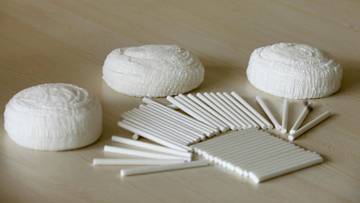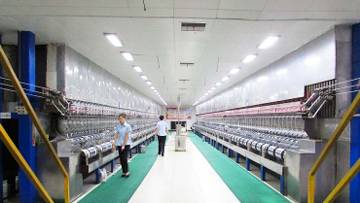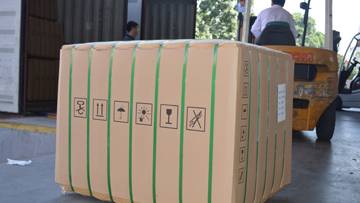Cellulose acetate tow manufacturers market tow with uniform pressure drop (PD) to cigarette filter manufacturers.
The relationship between PD and weight is called yield (PD/weight). Yield is usually represented as a straight line in a graph with weight on the x-axis and PD on the y-axis. The lowest end of the yield line is defined as the point at which the bar forms a concave end, while the highest end of the yield line is defined as the point at which the bar splits or the machine roll becomes entangled due to excessive filament bundles.Cigarette filters are very complex devices, and many factors affect their yield and performance. Because these factors are often interrelated with all complex installations, variations in one factor can affect others. When comparing filament suppliers, filter tip manufacturers consider these qualities. The robustness of the faggot quality is the deformation of the filter tip strip for a given load and a given contact time. The weight of the load unit and the contact time depend on the equipment used. The firmness is usually expressed as a percentage of the retention diameter (i.e., the higher the percentage, the more desirable). The PD variability of the quality of the strips is the uniformity of the PD of a large number of strips and is quantified by the Cv (coefficient of variation). The filter manufacturer wants the lowest possible Cv to produce the least variation in the delivery of the cigarette fuming element. Harness quality lint, also known as "linting", is not usually quantified, but is evident to the filter manufacturer when removing the harness from the pack or in the filter strip maker, and can be a significant source of defective filter strips (lumpy fibers, moth holes) and is the reason for more frequent cleaning of the defibrillator and the filter strip maker. The detangling quality of the filament bundle refers to the ease of detangling to fully open (deregister) i.e., "separate (bloom)" the filament bundle in the filter strip machine, and is rarely quantified, but is obvious to the filter manufacturer.
Obviously, the filter manufacturer wants a bundle product that provides a tobacco strip with desirable firmness and low PD variability, easy defibrillation, and no fly hair. In the prior art, such a product could not be obtained. In addition, the route to produce such a product is not clear due to the complexities associated with the production of cigarette filters and cigarette filter bundles.
Those of skill in the art know that firmness, pressure drop, PD variability, fly-hair, and defibrillation can be affected by filament bundle crimping. Curl is the corrugation imparted to synthetic fibers in manufacturing, and the degree of curl can be uncurled energy (UCE) tested. Those skilled in the art believe that affecting curl in order to improve one quality often compromises the other. For example, increasing UCE also increases flyaway (bad) and reduces PD variability (good) and inhibits unwinding (bad), while other process conditions remain generally unchanged.
Products with extremely high curl have been produced, but not without problems. For example, Rhodia Acetow produces a product under the trade name Rhodia SK. Rhodia SK is the result of a high yielding filament bundle (meaning high PD for low weight) and achieving high crimp. However, Rhodia SK still has greater than normal fly hairs and is difficult to unfiber under conditions normally used for conventional tow. This is in line with common sense. The difficulty associated with defibrillation can be seen by the requirement to change the conventional filter strip setup, i.e., additional work must be applied to fully open or "separate" the tow, which can be accomplished by changing the ratio of thread roll design, thread roll pressure, and/or roll speed of the said filter strip maker. This additional work leads to additional fly-hair due to fiber breakage.
Thus, the problem is how to produce a tow product that is easily defibrillated and provides a filter strip with the desired firmness, low PD variability, and low linting. Based on the prior art, such a product could not be obtained solely from highly curled filament bundles.
U.S. Patent No. 3,353,239 discloses a stuffing box crimper with a press feed roller having an annular groove.
Japanese patent No. 2964191 (based on Japanese patent application No. 1991-358234, which was filed on December 27, 1991) relates to a stuffing box crimper for cigarette tow production. The patent gives teaches that lubricating the edges of the filament bundle with a lubricant (e.g., water) at an injection rate of 25-50 cc/min prior to crimping reduces fly hairs.
U.S. Patent No. 3,305,897 discloses steam crimping of polyester tow in a stuffing box crimper. Two U.S. patents No. 5,225,277 and No. 5,618,620 disclose steam heat treatment of the tow upstream of the crimper or while the tow is in said crimper. Japanese patent application No. 54-127861 discloses heat treatment of a filament bundle upstream of the winder. U.S. Patent No. 5,591,388 discloses a method of producing curled tencel (lyocell, solvent spun cellulose) by employing a slightly superheated (dry) steam jet onto the fibers while they are curled in the filler box of a curling machine. The superheated steam has a pressure of 5 psi to 70 psi or greater.
WIPO Open No. WO02-087366 indicates that increasing curl also increases flyaway (lint) in the tow.

 English
English Español
Español Pусский
Pусский Tiếng Việt
Tiếng Việt 日本語
日本語 Deutsch
Deutsch Français
Français Türkçe
Türkçe العربية
العربية



 Provide Us Your Specifications
Provide Us Your Specifications Custom Made For You
Custom Made For You Prompt Delivery
Prompt Delivery